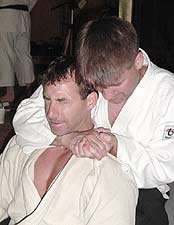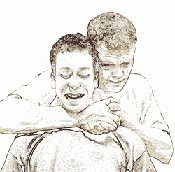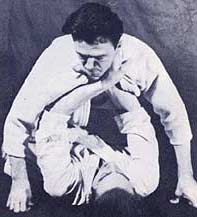The Judo Choke
By Neil Ohlenkamp
 Choking
techniques are some of the most universally taught techniques in the martial
arts and are found in jujutsu, aikido, Brazilian jujutsu, karate and in
many Chinese, Philippine and other arts. Of all the arts, Judo is perhaps
best known for the variety and sophistication of its many chokes. Choking
techniques are some of the most universally taught techniques in the martial
arts and are found in jujutsu, aikido, Brazilian jujutsu, karate and in
many Chinese, Philippine and other arts. Of all the arts, Judo is perhaps
best known for the variety and sophistication of its many chokes.
When you are against a very strong or determined opponent and everything
else seems to fail, the choke has proven over time to be one of the most
dependable techniques. If done properly, it acts quickly and causes no
physical damage and minimal pain. But if incorrectly applied, chokes can
be dangerous, even potentially fatal. In fact deaths attributable to incorrect
applications have led to choking techniques being banned in some law enforcement
jurisdictions. (1) If chokes are taught
safely, as in Judo, as a temporary incapacitating technique of short duration
done with proper execution, they should be quite harmless.
The practitioner must be careful, however. The practice of choking techniques
is a subtle art that requires attention to detail. Yet most texts on Judo
do little to enlighten the conscientious student on the finer points of
the technique. Most texts in imply that any pressure on the neck that
makes the opponent give up is a good choke. (2)
In fact, there are three basic ways of choking an opponent, as well as
some combinations of the three. In Judo, while all three are sometimes
used, emphasis is always on the safest methods.

This scissor motion is shown in the illustration.
|
Compression of the carotid arteries on one or both sides
of the neck restricting the flow of blood and oxygen to the brain.
This is the preferable and safest method. Notice how in the accompanying
illustration the person executing the choke has his arm positioned
around the neck (elbow in front) so to squeeze the sides of the
neck but avoid pressure on the windpipe in front.
|

Notice how the forearm is positioned directly
across the windpipe so pressure will cut of air flow into the
lungs.
|
Compression of the windpipe (trachea) stopping or reducing
the flow of air to the lungs. While sometimes effective this method
can be potentially dangerous and should be practiced with care.
Notice how in the accompanying illustration the forearm is positioned
directly across the windpipe so pressure will cut of air flow
into the lungs. While a lapel of a uniform pulled across the windpipe
to restrict air flow does not have a hard surface, a hard bony
forearm, or a policeman's night stick (law enforcement situations)
can potentially cause damage and should be avoided.
|
Compression of the chest and lungs preventing the opponent from
inhaling (often used during pinning techniques). This is a totally safe
method often used in conjunction with either of the above methods. If
you have ever had a heavy opponent pressing down his weight on your chest
you would understand how effective this method is in curtailing your ability
to breath.
These methods are sometimes distinguished by different terms and may
be referred to as choking, strangling, wringing, or necklocks. However
they are usually grouped together as a class of grappling techniques called
chokes, or shime waza.
The first choking method, compression of the carotid arteries, is stressed
in Judo and is the most commonly taught in Judo classes around the world.
This method is desirable because it requires the least force, is the quickest
acting of the choking techniques, is the most universally effective against
all opponents, and it is most in keeping with the efficiency principle
of Judo, "maximum effect with minimum effort."
These photos illustrate a simple rear naked (meaning use of just the
arms) choke (hadaka jime). As it is applied the forearms are squeezed
together (the wrist of the right hand also bent inward) to press against
the sides of the neck, thus restricting blood flow through the carotid
arteries. If done correctly the windpipe is not effected.
|
|
This type choke is also often taught in karate, kung fu, law enforcement
and self-defense classes since it is a useful standing technique.
A defender can, for example, block an attacker's roundhouse (hook)
punch (aimed at the head) with a simple vertical arm (to the inside)
and then sweep the attacking arm to the inside thereby spinning
the attacker's body so his back is turned towards the defender.
The attacker is pulled backward and down as the choke is activated.
If done properly the person will be incapacitated within seconds.
|
Medical tests have established that the amount of pressure needed to
occlude the arteries is six times less than the pressure needed to collapse
the airway. Directly stopping the blood supply to the brain also results
in loss of consciousness about six times faster than indirectly reducing
oxygen in the brain through restricting breathing or the flow of air to
the lungs. Excess pressure directly against the larynx can also be dangerous
since the applied pressure in some extreme cases can collapse this structure
and permanently cut off the practitioner's air supply.
|
|
Another effective rear choke (kataha jime) uses the lapel of the
uniform to exert pressure on the carotid arteries (minimal pressure
also being applied to the windpipe). The opponent's left arm (lifted
to his back) and controlled as part of the technique.
|
Carotid chokes are also safer and involve less pain than the other choking
methods, making them easier to practice and to acquire sufficient skill
to be confident in their use. Besides making them more effective, this
makes them more compatible with another principle of Judo, "mutual
welfare and benefit." A skillfully executed technique will give the
Judo student the ability to produce unconsciousness or submission with
little pain or forewarning to the person receiving the technique.
 The
illustration at right shows a simple front choke (kata juji jime). The
hands (palm up) are positioned as far up along side the neck, thumbs to
the outside, fingers inside the lapel of the uniform. Once a solid grip
is established the arms scissor open (elbows going outward) as the opponent
is pulled forward to create a powerful carotid choke. The
illustration at right shows a simple front choke (kata juji jime). The
hands (palm up) are positioned as far up along side the neck, thumbs to
the outside, fingers inside the lapel of the uniform. Once a solid grip
is established the arms scissor open (elbows going outward) as the opponent
is pulled forward to create a powerful carotid choke.
A good choke hold should render the opponent unconsciousness without
injury or significant pain in a matter of seconds regardless of who the
opponent is. The most basic requirements for applying such an effective
choke are:
• Make sure your own body always has complete
freedom of action so that you are in the best position for the technique
you intend to use and you are flexible enough to be able to respond to
your opponent's attempts to escape. Your position should be stable so
that in applying the technique you can use your entire body.
• Lead your opponent into a position in which
it is most difficult to put up resistance, but in which you can control
all of his or her actions. Your opponent must be unstable and under your
control as much as possible. Very often this means stretching out your
opponent's body backwards.
• Train your hands to get an accurate hold
the minute you begin a technique, make your choke work in a very brief
time, and once you begin the pressure, refrain from continually releasing
to adjust your position. Your techniques will have much greater effect
if you are firmly resolved not to let your opponent get away but to continue
until the end without slackening. Constancy of pressure, rather than extreme
force, is what is called for. Excessive reliance on strength would indicate
a defect in the technique since very little pressure is needed to compress
an artery and render a person unconscious.
Entire books can be written on the key points and details of choke holds.
Students of Judo around the world have been modifying and refining these
techniques for a century, testing them in contests as hard fought and
serious as Olympic competition. They have developed many variations in
the details of how best to utilize the legs, hips, chest, head, arms and
hands to maximize the effect of the choke. In some chokes the hands and
arms may use the lapel as if it were a thin cord to encircle the throat;
in others they may twist or rotate powerfully into the neck; and in yet
others they may pull or push to apply pressure directly to the carotid
triangle or trachea. Even the same basic choke can be applied effectively
in multiple ways depending on the position, relative size and movement
of the opponent as well as the training, strengths and preferences of
the individual. (3)
In whatever choke you apply, however, you should always have the safety
of your partner in mind. There is no substitute for good technique. If
you want to learn how to choke effectively and safely seek out a qualified
Judo instructor.
Another effective and widely taught standing choke taught in aikido,
jujutsu, karate, kung fu and in many other arts is a defense against a
straight punch is shown here. The defender deflects a straight punch to
the inside (or dodges it to the outside) with one hand while bringing
the other arm under the punch (across the attacker's body), as if reaching
for the attacker's ear (opposite the striking arm), the wrist ending on
the opponent's shoulder. The deflecting arm goes behind the attackers
head, the two hands gripping and pulling the attacker in (the actual grip
and elbow position differ depending on the art). The punching arm and
shoulder and the side of the neck are then pressed together to create
the choke which often ends in a take down.
Next
Page: Safety Rules
Footnotes:
(1) In an article, "DEATHS ALLEGEDLY CAUSED
BY THE USE OF "CHOKE HOLDS" (SHIME-WAZA) by E. Karl Koiwai,
M.D. the author examined deaths allegedly caused by "choke holds",
13 by law enforcement officers, and 1 by a student learning Vo et Vat,
a Vietnamese version of judo. He noted that the victims were not cooperative
and often under the influence of drugs and were thus difficult to restrain
(often a hard object such as a night stick was employed). He concluded
that "All these findings indicate that tremendous force was exerted
on the necks of the suspects" while "the police department training
manuals emphasize that control hold should be used only when necessary
to stop a suspect's resistance and not necessarily to cause unconsciousness."
The author also concluded: "In judo, the participants
are taught to "choke" properly and in turn have been "choked"
and have the ability to realize its effects before unconsciousness ensues.
The officials, referee, judges, and coaches can recognize the player when
he is "choked out" (becomes unconscious). If enforcement officers
are to use the choke holds to subdue violent suspects as a last resort,
they should be properly trained and supervised by trained certified judo
instructors."
(2) For example the general description of choking
techniques in Kodokan Judo by Jigoro Kano is "you use your hands,
arms, or legs on the opponent's collar or lapels to apply pressure to
his neck or throat." This excellent comprehensive manual of Judo
does not identify where on the neck the pressure is to be applied or the
most important objective of choking, which is to subdue violent opponents
with temporary unconsciousness.
(3) Explaining the techniques in detail is beyond
the scope of this article but as a brief reference, some of the basic
chokes of Kodokan Judo are:
o Nami juji jime or normal cross lock from the front
with arms crossed grasping the collars with the thumb inside.
• Gyaku juji jime or reverse cross lock from the
front with the fingers inside.
• Kata juji jime or half cross lock with one hand
fingers-in and one hand thumb-in.
• Hadaka jime or naked lock applied from the rear
with the forearm across the throat.
• Mae hadaka jime or front naked lock (sometimes
called the guillotine).
• Okuri eri jime or sliding collar lock applied
from the rear with one hand reaching around the neck grasping the collar
with the other hand reaching under the arm to the opposite collar.
• Kataha jime or single wing lock from the rear
with one hand around the neck to the collar but the other hand under the
arm and behind the neck
• Katate jime or one hand choke from the front or
side reach across the throat to the collar.
• Ryote jime or two hand choke from the front grabbing
the collars with the thumbs inside and turning your fists into the sides
of the neck.
• Sode guruma jime or sleeve wheel choke from the
front reaching around the back of the neck with one hand and across the
front with the other and grabbing your own sleeves.
• Tsukkomi jime or thrust choke from the front grasping
a lapel and pushing the fist directly into the side of the neck.
• Sankaku jime or triangle choke from the front
using the legs in a figure-four position around the neck and arm.
• Jigoku jime (hell strangle) from the rear with
one leg and one hand across the throat while the other leg and hand controls
the opponent's arms.
Editor's note: This article was adopted from an article
by Neil Ohlenkamp entitled "Principles of Judo Choking Techniques
- Different Chokes for Different Folks" appearing on his website
www.JudoInfo.com and is copyright
© 1995/96/97/98 by Neil Ohlenkamp, Encino Judo Club, California,
USA. This article was originally published in the January 1996 edition
of "Judo Trends Magazine." It is posted with the author's permission.
FightingArts.com also wants to thank Sensei Mike Hawley
(a teacher of aikido and a black belt in judo) and his assistant Paul
Britzzalaro of the Kintora
Martial Arts Center in Buffalo, NY for their demonstration of
several Judo chokes used in this article.
|